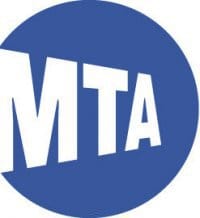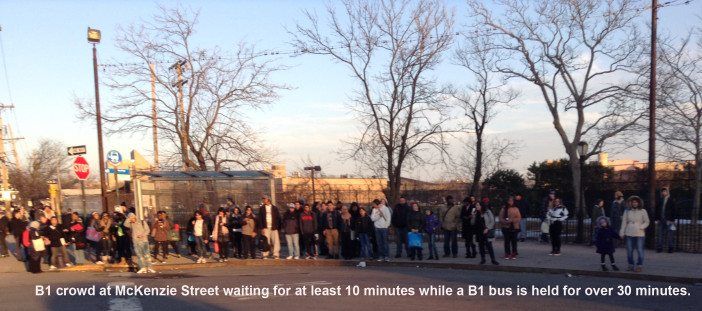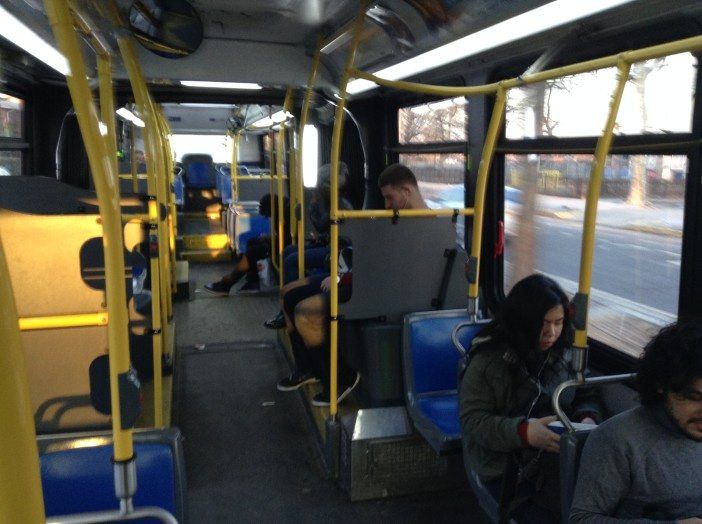The Commute: More MTA Bus Service Mismanagement


THE COMMUTE: We wrote about this subject numerous times. In 2012, we caught the MTA with their pants down. In 2014, we documented jam-packed B36 buses at Nostrand Avenue and Avenue Z, while the B44 and B44 SBS buses operated in both directions virtually empty during the morning rush hour.
On Sunday, March 8, while visiting a friend, we were standing at Brighton Beach Avenue and Ocean Parkway. There were two westbound B68s followed shortly thereafter by two westbound B1s. The exact same thing happened in the eastbound direction. The B68 had just left the Stillwell Terminal, which meant the buses left together, or only a minute or two apart. Within a few more minutes there were two more westbound B68s. That totals five pairs of buses within about five minutes. All buses were operating the full length of both routes.
Although each route should have had its buses spaced apart every 10 minutes, there were four B68s in the same direction within about five or 10 minutes. That means somewhere along the line passengers are waiting at least 30 minutes for a bus.
Brooklyn now has MTA Bus Time. We were promised that data from Bus Time would be used to help regulate the buses so they arrive at evenly-spaced intervals instead of in bunches. Why has that not happened?
On Wednesday, March 11, while visiting my friend again, we were at the same intersection at around 5:00pm. Again, there were two B1s in the westbound direction. However, this being a school day, one of the buses terminated there, with Ocean Parkway being the last stop. My friend thought the bus would turn around and make its next trip toward the Kingsborough Community College so I could take it home. I informed him that the shuttle buses operate in service only in the peak direction, which at this time of day was in the direction leaving the college. I made a mental note of the bus #5096.
I know from past experience that there is heavy demand in both directions at 5:00pm and already asked the MTA for shuttle buses to pick up in both directions at this time. Just as the bus made its U-turn at West 2nd Street and was waiting to cross Ocean Parkway, another bus made its turn onto Brighton Beach Avenue toward the college.
I got on and pushed my way to the back of the bus where there were still three seats available. Since there were already about 15 standees, I knew that there would not be enough room for the passengers needing to board at Coney Island Avenue. We were delayed by having to stop at Brighton 6th Street to pick up about 20 passengers who entered through both front and rear doors. That is because those passengers should have been picked up by bus #5096, which passed this stop about a minute earlier, not in service.
The bus was now packed and, as I expected, bypassed about 20 passengers waiting to board at Coney Island Avenue. Passengers who wanted to get off at the bypassed stop had to get off at the following stop instead.
http://youtu.be/WquwGKsVVE4
Bus #5096 also could have picked up those 20 passengers and left for the college with a seated load. It supposedly operated not in service in order to arrive more quickly at the college so as to pick up the heavier loads waiting there, as well as to be able to make more trips. The rationale was that the regular buses going towards the college should have been sufficient to handle the passenger loads. That obviously was not the case. The bypassed passengers had to wait another 10 or 20 minutes for yet another bus.
Since the MTA thought it was important for bus #5096 to get to the college so quickly that it could not take the time to pick up additional passengers, one would have thought that it would have immediately left the terminal. That didn’t happen. Instead, it stayed there for about 36 minutes. So why was it so imperative to save five minutes by not picking up passengers? Couldn’t the operator have started his break five minutes later? Would that have incurred overtime the MTA wanted so badly to avoid?
At The College
I started taking videos of the crowds waiting to board and buses picking up passengers eight feet away from the curb. Also, I saw at least four buses leaving “Not in Service.” Why shouldn’t all buses at least take passengers to the nearest subway station about one and a quarter miles away with hundreds of students waiting to board when classes change? It makes no sense. If all buses were in service, bus requirements would be reduced saving the MTA money.
http://youtu.be/e63QUIUJOpA
A student wondering what I was doing told me that he is also documenting the service by recording bus numbers and times. He advised me to speak to the dispatcher whom I had not even noticed. I informed the dispatcher that 20 passengers could not board at Coney Island Avenue because the buses were too crowded and asked him why the shuttle buses would not pick up those passengers. He replied that some buses do pick up in both directions. I asked him why operate a bus not in service only for it to layover for more than 30 minutes. He informed me that it was not a layover and he held the bus operator before making his final trip of the day.
That would only make sense if there was a gap in service and classes would be letting out in 30 minutes. At 6:27pm there were already more than 60 passengers waiting to board for at least 10 minutes (see lead picture) and buses arriving later were dispatched ahead of this bus, so why hold this particular bus?
Bus #5096 finally picked up passengers at 6:29pm about 36 minutes after it arrived and the driver did not even bother to pull into the bus stop. Operating the bus not in service from Ocean Parkway did not help the students waiting to board at the college and hurt those traveling toward the college.

At 6:23pm, five buses were discharging passengers 400 feet from the terminal between Langham Street and Kensington Street, although the terminal was completely void of buses. For more than 10 years, Community Board 15 has complained to the MTA about this practice, which requires passengers to walk an extra two blocks for no reason. Remember, this video shows students walking in the “off-peak” direction, the opposite direction the extra shuttle buses are traveling.
http://youtu.be/e1BkBomPVSU
It Gets Even Worse
Now the dispatcher noticed I was taking videos and he told me to stop because he said it was not allowed. He threatened to call the cops and have me arrested if I continued. When I inform him that I worked for the MTA for 25 years, he replied, “Then you should know better.” I see two possible interpretations. Employees should stick up for each other; or they should know better than to care. Then he talked to me again, trying to convince me that he was properly doing his job after I told him that he wasn’t.
Now I wanted to go home. There was a break between the next wave of students and the bus stops are now almost deserted. I had my choice of buses so I decided to take the articulated B49. It left with only a half dozen passengers because the dispatcher did not decide to hold it for the hundreds of students who would have been arriving when classes broke, which would have been a legitimate hold.
Also note that someone at the MTA is reading Sheepshead Bites because this bus is no longer free. The slot for MetroCards is no longer covered over with paper.

So ask yourself the following question: Why should a shuttle bus be scheduled to operate non-stop toward the college when that delays the bus behind it? Not only that, it causes it to be so overcrowded that it must pick up an additional 20 passengers and bypass 20 more waiting at Coney Island Avenue. When the shuttle bus does arrive at the college, why is it held out of service for about 36 minutes just before the operator’s final scheduled 30-minute trip of the day while buses arriving later are used to handle the crowds?
There is a simple explanation. Can you figure it out? I gave you a clue earlier.
The Commute is a weekly feature highlighting news and information about the city’s mass transit system and transportation infrastructure. It is written by Allan Rosen, a Manhattan Beach resident and former Director of MTA/NYC Transit Bus Planning (1981).
Disclaimer: The above is an opinion column and may not represent the thoughts or position of Sheepshead Bites. Based upon their expertise in their respective fields, our columnists are responsible for fact-checking their own work, and their submissions are edited only for length, grammar and clarity. If you would like to submit an opinion piece or become a regularly featured contributor, please e-mail nberke [at]sheepsheadbites [dot]com.



